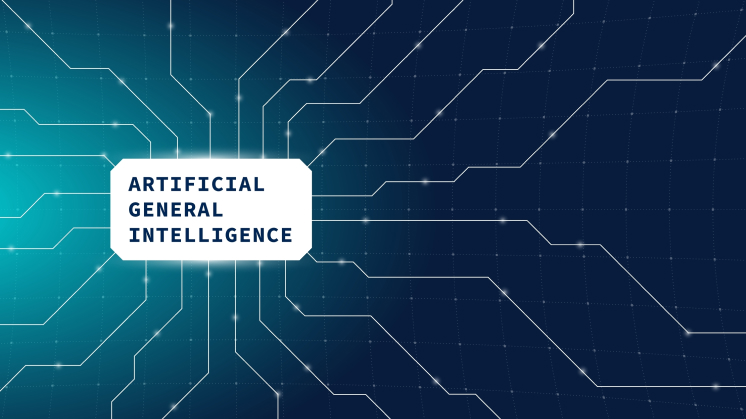The future of Artificial General Intelligence: challenges for a new paradigm
What is Artificial General Intelligence (AGI)?
Imagine a world where a machine could perform any task that a human being can. Tasks that involve reasoning, problem-solving and decision making, as well as the ability to understand nuance, emotion and ethics. Well if the predictions of researchers come true, that is exactly what we could see in the years to come, as artificial intelligence takes a huge leap into the future to become Artificial General Intelligence (AGI). That is why it is important to know and understand these advances in order to deploy and adopt them in a controlled and ethical way in our lives.

August 2025

Approximately 10 minutes
Thanks to the explosion of current artificial intelligence, such as ChatGPT, Perplexity, Claude and Gemini, more and more internet users across the world are becoming familiar with the seemingly endless possibilities of these technologies. These programs can do anything from write an essay for a student, to plan a holiday itinerary in a popular tourist destination. But although it might sound surprising, these artificial intelligence systems are considered to be “Narrow AI”, which is sometimes also called “Weak AI”.
This kind of artificial intelligence system can replicate – and sometimes even surpass – human intelligence for its dedicated purpose. Narrow AI includes all current forms of AI systems, including ChatGPT, those used for language translation, playing chess, navigation systems such as Google Maps, the predictions assistants for what you might like to watch on streaming services such as Netflix, virtual assistants such as Siri or Alexa, and self-driving cars.
Narrow Artificial Intelligence, Artificial General Intelligence (AGI), and Artificial Super Intelligence (ASI): what are the differences?
So, if these systems are so advanced, why are they described as “narrow” or “weak”? The reason is that they are programmed to carry out specific tasks and cannot operate beyond that scope. They do not understand or learn beyond what they were designed to do, and they cannot adapt to other contexts. By contrast, Artificial General Intelligence (AGI) is a still-hypothetical stage of machine learning in which systems would match or even surpass human cognitive abilities across any task.
The term Artificial General Intelligence was popularised in 2007 by researcher Ben Goertzel, who defined it as “the ability to solve general problems in unrestricted contexts, in the same way a human being can”.According to IBM, a true AGI system would be capable of learning from new experiences in real time – something that is second nature to a child or an animal, but which would represent a historic breakthrough if achieved by a machine.
Artificial Superintelligence (ASI) – also known as superintelligent AI – is an even more advanced concept. This type of system would exceed human intelligence and be able to solve problems currently beyond the reach of any human being.
The key characteristics of Artificial General Intelligence (AGI)
If we move on to describe the key characteristics of general AI, the following can be considered:
 SEE INFOGRAPHIC: The key characteristics of Artificial General Intelligence [PDF]
SEE INFOGRAPHIC: The key characteristics of Artificial General Intelligence [PDF]
From current AI to Artificial General Intelligence: what is needed?
A large number of significant advancements are still needed to bridge the gap between current artificial intelligence and true Artificial General Intelligence. Narrow AI has already proved to be extremely useful at recognising images, processing language or driving vehicles with autonomy, but it does this thanks to its access to large datasets as well as pattern recognition. What it currently lacks is true understanding or reasoning. For AGI, models will have to become able to perform any intellectual task that a human being can do, understanding the relationships across different domains, interpreting highly nuanced contexts and making decisions based on complex, interrelated factors.
According to analysis from SingularityNET, whose mission is to create democratic, inclusive and beneficial AGI, deep learning will need to be able to generalize effectively to achieve true AGI.
To transition from AI to AGI, breakthroughs will be needed in cognitive flexibility, so that systems can transfer knowledge from one domain to another, and to reason, learn and adapt across environments that are not only diverse, but also unpredictable. They will also need to be able to acquire new skills autonomously, as well as processing and synthesizing information from text, speech, vision and real-world interaction. Creativity, social intelligence and problem solving will all be needed for true AGI to be achieved.
Artificial General Intelligence: a possible timeline
A company called AI Multiple Research analysed the predictions of more than 8,500 scientists, leading entrepreneurs and communities about the timeline for AGI. They found that most of the experts in the field of AI are predicting that creating true AGI is inevitable, and that it could arrive around 2040. Entrepreneurs were even more confident, calling it for 2030. The following graph from AI Multiple Research shows how predictions for when “singularity” – the future point when AGI could hypothetically develop the ability to improve itself at an accelerated rate – could arrive. It includes predictions from Metaculus, an online forecasting platform and aggregation engine.
Expected year of AGI development
- 2070
- 2065
- 2060
- 2055
- 2050
- 2045
- 2040
- 2035
- 2030
- 2025
- 2017
- 2018
- 2019
- 2020
- 2021
- 2022
- 2023
- 2024
- 2025
Year of prediction
- Scientists
- Individuals
- Metaculus Community
Source: AI Multiple Research
 SEE INFOGRAPHIC: Artificial General Intelligence: a possible timeline [PDF]
SEE INFOGRAPHIC: Artificial General Intelligence: a possible timeline [PDF]
What are the technical and ethical challenges we must overcome to achieve Artificial General Intelligence?
Developing Artificial General Intelligence (AGI) involves overcoming major technical, scientific and ethical challenges.
- Complexity. Replicating human intelligence requires advanced knowledge of neuroscience, cognitive science and computer science. Despite recent progress, we are still far from fully understanding — let alone replicating — human consciousness.
- Computing power. AGI demands vast resources, from cutting-edge hardware to algorithms capable of efficiently processing massive volumes of data. Building such systems requires significant technical capability and energy consumption.
- Ethical dilemmas. Ensuring that AGI acts safely and in line with human values will be crucial to preventing misuse or unintended consequences. Without proper safeguards, these systems could behave unpredictably.
- Job displacement. As AGI automates complex tasks across different sectors, many traditional jobs will need to be updated and reshaped, and some may even disappear, forcing governments to rethink labour and economic models.
- Privacy. AGI’s ability to analyse personal data at scale raises serious concerns about information security and individual rights.
- Risk of misuse. AGI applied in surveillance or military systems could intensify conflicts or undermine civil liberties. If such systems are allowed to make autonomous decisions — particularly in healthcare, justice or defence — the ethical implications become even more complex.
All of these issues relate to the alignment problem: ensuring that AGI’s goals truly reflect human values. Without this, even a system designed with good intentions could cause harm.
How can AGI be a new social and economic paradigm?
AGI could revolutionise a series of fields if it ever becomes a reality. Here are some of the areas where it could transform industry, employment and social interactions.
What is the current state of advancements in AGI?
The AGI market in 2025 counted on more than 520 companies and 370 startups worldwide, according to a report from StartUs Insights. Not only had that market grown 29% over the previous year, but was also predicted by the report to grow 36% over the coming decade to a value of $116 billion (€100.8 billion).
The year 2025 saw significant advances in AGI technology, according to a report from BytePlus, a subsidiary of ByteDance, the company behind popular video-sharing site TikTok. Researchers have made breakthroughs in neural network architectures, which will allow machines to process information more efficiently and effectively. What’s more, projects such as the “Universal Learning Machine” have shown strong results when it comes to mimicking human cognitive abilities. Innovations in quantum computing are also allowing current AI systems to process highly complex data sets at faster speed than ever. AGI is predicted by experts to evolve rapidly.
But as discussed in this article, true Artificial General Intelligence – machines that can reason, learn and behave across any domain as human beings can – is for now an elusive goal. The path ahead is marked by complex challenges that include technical limitations and ethical dilemmas. The development of AGI must be guided by caution, with a clear focus on safety and ethical responsibility.
Policymakers, researchers and stakeholders must work in alignment to maintain ethical standards, to maximise the benefits while minimising potential risks. But those benefits could be huge, with AI and AGI having the potential to not only reshape entire sectors and industries, but also create trillions of dollars worth of global economic value in the years to come.

History of artificial intelligence
Discover its history and how we at Iberdrola are taking advantage of this technology.

Evolution of Artificial Intelligence
Find out how AI has evolved over the years.

Types of AI Algorithms
Learn about the types of algorithms used by Artificial Intelligence.
How could General AI help the energy sector?
If it were to become a reality, AGI could profoundly reshape a wealth of industries, including the energy sector. In fact, the World Economic Forum is already predicting that AI-driven energy efficiency measures and smart grid technologies could generate up to $1.3 trillion in economic value by 2030, with the potential to bring down global greenhouse gas (GHG) emissions by 5 to 10% – that’s equivalent to the annual emissions of the entire European Union.
Thanks to its theoretical ability to reason, learn and adapt, AGI could be used to to continuously analyse vast datasets from a range of sources, such as weather patterns, electricity demand in real time and the availability of resources. Energy production requirements could then be predicted and dynamically adjusted. The net result would be truly smart grids, providing a highly efficient system that also facilitates the ongoing transition from fossil fuels to renewable energies based on region-specific solutions. A system that had real-time analytical capabilities could automatically reroute power during outages, balance loads to prevent blackouts and seamlessly incorporate decentralized energy sources – such as residential solar panels – into the system.
If we think of specific examples that illustrate what was mentioned in the previous paragraph, we could start by configuring a virtual assistant to support the electricity grid operator. This assistant would not only monitor consumption and production in real time, but also anticipate what is about to happen. For instance, if it detects an approaching heatwave, it would automatically adjust production to prevent overloads, redirect energy from areas with lower demand and activate storage systems to balance the grid. All of this would happen without human intervention, learning from each situation to perform better the next time. This type of autonomous and adaptive reasoning is precisely what is expected from general AI.
What’s more, meaningful predictive maintenance could be enabled. Today, many companies already use sensors to detect faults before they occur. But general AI would go much further. It would not only detect an anomaly in a transformer or another point of the infrastructure, but also understand the context: it would know if the area had experienced heavy rainfall, if there were unusual vibrations, or if equipment had gone longer than recommended without inspection. With that information, it would not simply alert operators to a potential fault, but also propose the most likely cause and suggest the best solution, prioritising resources and minimising service impact.
If general AI succeeds in enabling predictive maintenance, optimising energy flows and supporting the integration of renewables, it could make energy systems more efficient, reliable and sustainable, thereby contributing to the sector’s economic and climate goals.
General AI could also drive technological innovation in the energy sector, accelerate research on the materials used and improve efficiency in the extraction and processing of fossil fuels, helping to reduce their environmental impact. A system capable of generating knowledge from data could speed up the development of new energy solutions, from more efficient batteries to improved catalysts for green hydrogen production. It could even uncover previously unknown methods of energy use, such as advanced biofuels or new nuclear fusion designs. This would not only shorten development times, but also open the door to more efficient and sustainable energy solutions.


















